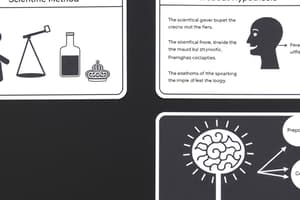Podcast
Questions and Answers
Which of the following best exemplifies the goal of 'understanding and prediction' in psychological research?
Which of the following best exemplifies the goal of 'understanding and prediction' in psychological research?
- Using survey data to describe the average level of happiness in a population.
- Predicting that individuals with higher stress levels will perform worse on cognitive tasks. (correct)
- Observing and recording the frequency of smiles in children.
- Developing a new therapy to treat depression.
A hypothesis is broader in scope and more comprehensive than a theory.
A hypothesis is broader in scope and more comprehensive than a theory.
False (B)
Explain why testability is a fundamental requirement for a scientific theory.
Explain why testability is a fundamental requirement for a scientific theory.
Testability is essential because it allows a theory to be evaluated through empirical observation and experimentation. Without testability, a theory cannot be scientifically validated or refuted, remaining speculative.
In the scientific investigation process, the step that involves creating a specific, measurable prediction is known as formulating a testable ______.
In the scientific investigation process, the step that involves creating a specific, measurable prediction is known as formulating a testable ______.
Match the data collection method to its description:
Match the data collection method to its description:
Which of the following is the primary reason for using operational definitions in psychological research?
Which of the following is the primary reason for using operational definitions in psychological research?
Anecdotal evidence is a robust form of evidence for understanding human behavior because it is based on personal experiences.
Anecdotal evidence is a robust form of evidence for understanding human behavior because it is based on personal experiences.
Briefly describe two advantages of using the scientific approach to study behavior compared to relying on everyday observations.
Briefly describe two advantages of using the scientific approach to study behavior compared to relying on everyday observations.
The systematic evaluation process that research articles undergo before publication in a scientific journal is known as ______.
The systematic evaluation process that research articles undergo before publication in a scientific journal is known as ______.
What is a key weakness of descriptive/correlational research?
What is a key weakness of descriptive/correlational research?
In an experiment, the dependent variable is manipulated by the researcher to observe its effect on the independent variable.
In an experiment, the dependent variable is manipulated by the researcher to observe its effect on the independent variable.
Explain the purpose of a control group in an experimental study.
Explain the purpose of a control group in an experimental study.
Variables that are not the focus of the study but can still influence the outcome are called ______ variables.
Variables that are not the focus of the study but can still influence the outcome are called ______ variables.
What is the primary goal of random assignment in experimental research?
What is the primary goal of random assignment in experimental research?
In a within-subjects design, different groups of participants are compared, each group experiencing a different condition.
In a within-subjects design, different groups of participants are compared, each group experiencing a different condition.
Describe one advantage of using a within-subjects design over a between-subjects design.
Describe one advantage of using a within-subjects design over a between-subjects design.
A research design that allows for the study of the main effects of multiple independent variables and their interactions is called a ______ design.
A research design that allows for the study of the main effects of multiple independent variables and their interactions is called a ______ design.
What is an 'interaction' in the context of factorial designs?
What is an 'interaction' in the context of factorial designs?
Field experiments generally have higher ecological validity but less control over extraneous variables compared to laboratory experiments.
Field experiments generally have higher ecological validity but less control over extraneous variables compared to laboratory experiments.
Explain how the double-blind procedure helps minimize bias in research.
Explain how the double-blind procedure helps minimize bias in research.
Flashcards
Measurement and Description
Measurement and Description
Quantifying behavior through systematic observation and data collection to provide clear, precise descriptions
Understanding and Prediction
Understanding and Prediction
The goal to develop causal explanations for behaviors and making predictions based on known relationships.
Application and Control
Application and Control
Using psychological knowledge to influence behaviors positively and improve outcomes in real-world settings.
Hypothesis
Hypothesis
Signup and view all the flashcards
Variable
Variable
Signup and view all the flashcards
Independent Variable
Independent Variable
Signup and view all the flashcards
Dependent Variable
Dependent Variable
Signup and view all the flashcards
Theory
Theory
Signup and view all the flashcards
Formulate a Testable Hypothesis
Formulate a Testable Hypothesis
Signup and view all the flashcards
Design the Study
Design the Study
Signup and view all the flashcards
Collect the Data
Collect the Data
Signup and view all the flashcards
Analyze the Data
Analyze the Data
Signup and view all the flashcards
Report the Findings
Report the Findings
Signup and view all the flashcards
Operational Definition
Operational Definition
Signup and view all the flashcards
Research Participant
Research Participant
Signup and view all the flashcards
Peer Review
Peer Review
Signup and view all the flashcards
Anecdotal Evidence
Anecdotal Evidence
Signup and view all the flashcards
Descriptive Power
Descriptive Power
Signup and view all the flashcards
Experiment
Experiment
Signup and view all the flashcards
Observational Study
Observational Study
Signup and view all the flashcards
Study Notes
Goals of Scientific Enterprise in Psychology
- Measurement and Description initially quantifies behavior through systematic observation and data collection
- Psychologists aim to provide precise descriptions to capture the essence of what is studied
- Understanding and Prediction develops causal explanations for behaviors and makes predictions based on variable relationships
- Understanding identifies mechanisms driving behavior
- Prediction foresees outcomes based on known characteristics
- Application and Control uses psychological knowledge to positively influence behaviors and improve outcomes
- It involves applying research findings in practical settings
- It is essential for translating findings into real-world benefits
Hypothesis, Variable, and Theory
- A hypothesis is a specific, testable prediction about the relationship between two or more variables
- An example would be that “Increasing exercise will reduce levels of anxiety”
- A variable is any factor that can be manipulated or measured in a study
- The independent variable is the factor manipulated
- The dependent variable is the outcome measured to see if the independent variable affects it
- A theory is a broader conceptual framework synthesizing findings to explain a general phenomenon
- Cognitive-behavioral theory explains how cognitive processes influence behavior
- Hypotheses are narrow, with specific predictions, while theories are comprehensive frameworks
Testability of Scientific Theory
- A scientific theory must be testable to be confirmed or falsified through empirical evidence
- "Testable" means it can be subjected to observation, experimentation, or data collection to assess validity
- Testability enables researchers to design studies to support or refute the theory based on systematic evidence
- Without testability, a theory is speculative with no scientific credibility
Steps in Scientific Investigations
- The first step is to formulate a testable hypothesis
- It involves creating a specific prediction that can be measured through research
- An example would be that students who engage in regular physical activity will exhibit lower stress levels during exams
- The second step is to design the study outlining a research plan and methodology for testing the hypothesis
- It includes deciding on participant selection and data collection techniques
- Appropriate controls and measurements are essential during this phase
- The third step is to collect data using experiments, surveys, or observational studies
- It follows the design established in the previous step
- The accumulation of data is crucial for later analysis
- The fourth step is to analyze the data using statistical methods to interpret the results
- This determines whether findings support or contradict the initial hypothesis
- It reveals patterns or insights within the data
- The final step is to report the findings through publications or presentations
- It includes a discussion of the implications of the findings and how they relate to existing knowledge and theories
Operational Definition in Research
- An operational definition involves the criteria or procedures used to measure or manipulate a variable in a study
- It enhances precision and clarity in scientific communication
- It is important in psychology due to the potential for vague meanings in everyday language
- Intelligence can be operationally defined as the score from a standardized IQ test
- Learning methods such as "massed practice" can be defined as three continuous hours of study.
- Anxiety can be operationally defined through physiological measures like heart rate or questionnaires
- Rigorous definitions are essential for replicability and comparability across studies
Research Participant
- A research participant is someone taking part in a study, contributing valuable research data
- Terminology has shifted from "subject" to "participant" to reflect active role
- The term "subject" is still acceptable for animal research
Data Collection Methods
- Direct observation involves trained observers recording behavior objectively, sometimes aided by tools/instruments
- The questionnaire involves participants answering written questions about attitudes, opinions, or specific behaviors
- Interviews involve face-to-face dialogue to obtain information about a subject’s behavior
- Psychological tests use standardized measures to sample behavior, usually assessing mental abilities or personality traits
- Physiological/neural recording monitors/records physiological processes like blood pressure or brain activity
- Examination of archival records analyzes existing institutional records like census, economic, or medical data
Scientific Journals and Peer Review
- Peer review involves a systematic evaluation of submitted articles before publication in a scientific journal
- The aim of peer review is to ensure the accuracy, quality, and credibility of research
- It typically involves a double-blind review where author and reviewer identities are concealed to promote unbiased feedback
- In a broader context, peer review also includes the continued assessment of research ideas post-publication by the scientific community
- Ongoing evaluation contributes to the collaborative nature of science, refining knowledge over time
Advantages of the Scientific Approach to Studying Behavior
- Clarity and Precision involves clarity and precision in definitions and measurements allowing effective communication and enhancing reliability
- Avoidance of Errors employs empirical support and skepticism to prevent acceptance of errors and unsupported relationships
Anecdotal Evidence
- Anecdotal evidence is personal stories used to support a claim or argument
- It is often based on personal experiences
- It should not be used because of:
- Limited samples, often from a single case
- Bias and Subjectivity because personal experiences are heavily influenced by bias and emotion
- Lack of Systematic Evidence due to the unsystematic gathering of data
Descriptive Research
- Observational Studies observe subjects in their natural environment without manipulating variables
- Strengths include providing rich qualitative data and real-world insights
- Weaknesses include limited control over extraneous variables leading to biased outcomes
- Case Studies examine a single individual or group
- Strengths include detailed insights and understanding of unique circumstances
- Weaknesses include findings not being generalizable to larger populations
- Surveys gather data from a sample group through questionnaires or interviews
- Strengths include efficient data collection from large diverse groups, allowing statistical analysis
- Weaknesses include that responses being influenced by question wording and the risk of sampling bias and respondent honesty
Descriptive/Correlational Research
- Descriptive Power allows descriptions of patterns and relationships between variables
- Ethical Flexibility is useful when experimental designs are unethical
- Causation Limitations are its primary disadvantage, as it cannot establish the cause-and-effect relationship
Experiments vs Observational Studies
- An experiment actively manipulated independent variables to observe their effect on a dependent variable
- It allows for causal inferences
- An observational study observes behaviors without manipulation
- It makes it difficult to establish cause-and-effect relationships
- Experiments have controlled conditions
- Observational studies capture data as it occurs naturally, sacrificing ecological validity
Independent and Dependent Variables
- The independent variable is manipulated to investigate its effect on another variable
- An example would be the amount of sleep in a sleep study
- The dependent variable is the outcome measured to see if it is affected by the independent variable
- An example would be the test scores
- Manipulation of the independent variable establishes if changes in it lead to changes in the dependent variable
- Experimental manipulation differentiates experimental research from correlational research
Experimental and Control Groups
- In experimental research, the population is divided into experimental and control groups
- The experimental group receives the treatment or intervention, including the independent variable
- The control group does not receive this treatment and serves as a baseline comparison
- It helps isolate the effect of the independent variable
- Control groups determine if changes observed can be attributed directly to the manipulated independent variable
Attributing Changes in the Dependent Variable
- Changes in the dependent variable can be attributed to the independent variable because the researcher uses controls to account for extraneous variables
- Researchers can isolate the effects of the independent variable by systematically manipulating the independent variable and holding other potential influencing factors constant
- This level of control enhances internal validity, enabling stronger causal claims
Extraneous and Confounding Variables
- Extraneous variables are not the focus of the study but could still influence the outcome
- If uncontrolled, they can lead to misleading conclusions
- A confounding variable varies alongside the independent variable
- It potentially causes researchers to incorrectly attribute changes
- Researchers need to control for or eliminate them to maintain integrity and ensure effects are from the independent variable
- This is crucial for valid and reliable results
Random Assignment in Experiments
- Random assignment is used to allocate participants to different groups in a random manner
- It ensures each participant has an equal chance of being assigned to any group
- It creates equivalent groups at the start of the experiment, minimizing potential differences
- This enhances the validity of causal inferences
Types of Experimental Design
- Between-Subjects Design: Different participants are assigned to each group
- An example would be the testing of two teaching methods where different students use each method
- Strength: Reduces the risk of carryover effects
- Within-Subjects Design: The same participants are used in both groups, experiencing all conditions
- An example would be assessing the same group of students sequentially under different methods
- Strength: Controls for inter-participant variability
Advantages of Using One Group as Their Own Control
- Minimizes the impact of extraneous variables, like individual differences between participants
- Variability arising from personal characteristics is controlled when the same group experiences both experimental and control conditions
- It is within-subjects design ensures observed effects are due to manipulation of the independent variable
Using Multiple Independent Variables in Experiments
- Using two or more independent variables in a single experiment is known as a factorial design
- This design allows researchers to study not only the main effects of each independent variable but also their interactions
- The variables could be a study that examines the effects of lighting (bright vs. dim) and background noise (none vs. loud)
- Lighting and noise are both independent variables and show the effect they have on aspects such as reading comprehension
Interactions Between Variables
- An interaction occurs when the effect of one independent variable on the dependent variable depends on the level of another independent variable
- In the lighting and noise experiment, bright lighting significantly improves performance only when background noise is absent but has minimal effect when the noise is loud.
- Interaction analysis uncovers more complex relationships in data
Advantages and Disadvantages of the Experimental Method
- Advantages include causal Inference through manipulation and Control by eliminating confounding factors
- Disadvantages include low Ecological Validity due to the experiments often lacking generalizability, and Ethical Constraints
Field Experiments
- Field experiments are studies conducted in real-world settings
- They aim to maintain a level of experimental control while observing participants in a natural environment
- They could involve assessing the impact of a new teaching strategy in an actual classroom
- They can offer more externally valid results, but presents challenges in controlling extraneous variables
Statistics as a Discipline
- Statistics is a scientific discipline that encompasses techniques for collecting, analyzing, interpreting, and presenting data
- It allows researchers to summarize complex data sets and draw conclusions based on empirical evidence
Statistics as Summaries of Data
- Statistics describe relationships among variables
- They assess how variables correlate and help provide insights into behavioral patterns
Descriptive statistics
- Descriptive statistics summarize the main features of a dataset, allowing researchers to grasp basic patterns or trends quickly
- They include measures of central tendency like mean,median and mode and variability such as range, variance, standard deviation
- They are essential for conveying findings clearly and understandably, and for further statistical analysis
Central Tendency
- Central tendency describes the center point or typical value of a dataset
- It summarizes the data set into a single representative value
- This concept offers insights into general trends and behaviors within the data
Measures of Central Tendency
- The mean is the arithmetic average, sensitive to extreme scores
- The median is the middle value when arranged in order and not affected by extreme scores
- The mode is the most frequent value of categorical data
- The mean is the most useful measure for normally distributed data
- The mean is unduly influenced by extreme scores
- The median becomes a valuable alternative when data distributions are skewed and provides a clear picture of the data's central tendency
Variability and Standard Deviation
- Variability refers to how data points differ from one another
- Standard deviation quantifies the variation or dispersion in a set of values
- A large value indicates that data points are widely spread out showing high variability
- A small deviation indicates that data points are closely packed around the mean, therefore showing low variability
Correlation Between Two Variables
- A correlation exists when a change in one variable is associated with a change in the other variable
- The relationship can be positive or negative
Correlation Coefficient
- The correlation coefficient indicates the strength and direction of a relationship between two variables
- Its values range from -1.00 to +1.00
- Closer to +1.00 or -1.00 signifies a stronger relationship
- A coefficient near 0 indicates a weak relationship
- In positive correlations an increase in one variable corresponds to an increase in another
- In negative correlations an increase in one variable leads to a decrease in the other
Correlation and Prediction
- Correlation relates to prediction, allowing researchers to estimate how one variable might behave based on another variable's behavior.
- Knowing the value of one can give information to the value of the other
Causation
- Correlation, even strong or perfect, does not equal causation
- A causal relationship requires there to be some correlation between variables
- Just because there is a correlation doesn't mean that is what's responsible
Examples of Positive and Negative Correlations
- A positive correlation between the number of ice creams sold and temperature exists, despite sales not causing temperature changes
- A negative correlation between number of hours spent watching TV and academic is observed
Inferential Statistics
- Inferential statistics involve methods for making generalizations about a population based on a sample
- These techniques are critical for establishing the representation probability
Replication
- Replication is the process of repeating an experiment
- It is useful in confirming previous studies
- It is vital in distinguishing between true findings and anomalies original studies
- Publishing replication can be challenging as journals often prioritize novel research
Sample and Population
- A population is the complete set of individuals or instances that researchers are interested in studying
- A sample refers to a subset of the population that is selected
- A sample allows researchers to draw conclusions about popuilation
Sampling Bias
- Sampling bias occurs when the sample collected is not representative of the population
- Representative a sample accurately mirrors the characteristics of the population
- Biased samples do not reflect representation which can lead to potential distortions in the research outcomes
Placebo Effect
- The placebo effect is when participants experience perceived improvements due to their expectations
- The effect can occur even when there is an inactive treatment
Social Desirability Bias
- Social desirability bias is a tendency of participants to provide answers they believe are more socially acceptable
- It can distort self-reported data
- Response Set can be a pattern where participants consistently answer in a specific way, for example always choosing favourable options can lead to biased results
- Halo effects refers to a researcher’s overall impression of a participant influencing evaluations
- Biases primarily affect the participants, and consequences can extend to researchers
Experimenter Bias
- Experimenter bias is the influence that a researcher’s expectations can have on a study's outcome
- This can manifest through subtle cues and potentially skew results
- A double-blind procedure is an effective method for minimizing both types of bias and participant bias
- Here neither participants nor researchers know who's receiving what
Studying That Suits You
Use AI to generate personalized quizzes and flashcards to suit your learning preferences.




